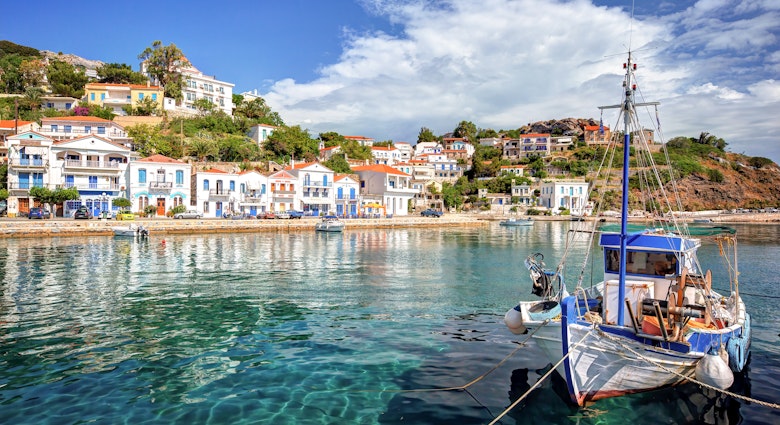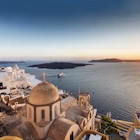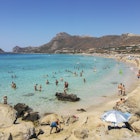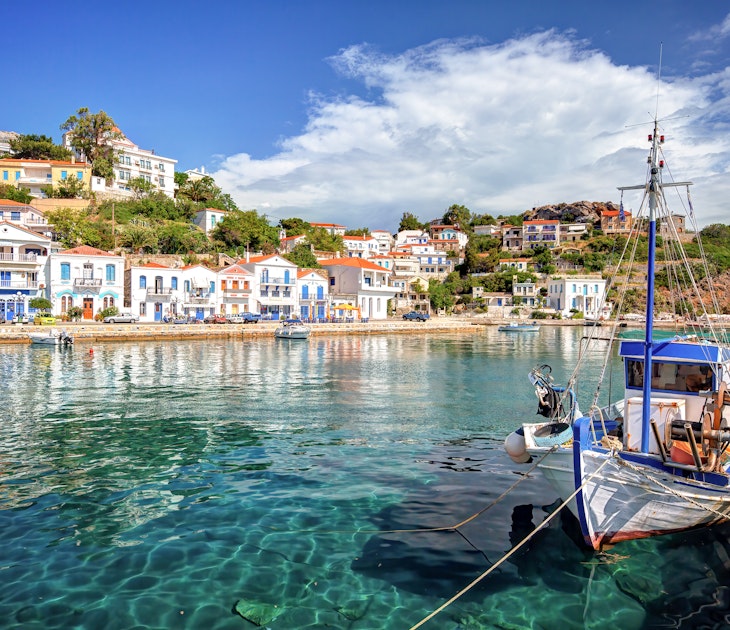

Here's everything you need to know about visiting the Acropolis in Athens.
Overlooking modern-day Athens, the mighty Acropolis is a powerful reminder of the city's ancient history. Inhabited since the Bronze Age, this "high city" served various purposes, from housing Greece's kings to being a center for worship and intellectual activity.
Through natural disasters, foreign invasions and periods of neglect, the Acropolis has proven it was built to last and serves as a symbol of resilience. Many ancient cities around Greece also had their own Acropolis, but the Athenian Acropolis is undoubtedly the most famed, now attracting about three million visitors a year.
Beyond the iconic Parthenon, the site boasts numerous other attractions. Read on for how to get the most out of your visit.
When should I go to the Acropolis?
The best time to visit the Acropolis is during the shoulder seasons of April, May, and October. Summer, particularly in July and August, marks Greece's peak season, drawing large crowds of both local and international tourists. Consequently, the Acropolis can be extremely busy during this time. While summer days can be pleasant, Greece also experiences heatwaves, which have become unbearable in recent years, and as such, the Acropolis closes during the hottest days to protect people. To ensure access, it's best to check the news or the official ticket website for updates. Visiting during the milder temperatures of spring and fall not only offers a more comfortable experience but also reduces the risk of slippery conditions caused by rain during the winter months.

How much time should I spend in the Acropolis?
You could easily spend two or three hours exploring. Beyond the Parthenon, there are more than 30 points of interest that make up the Acropolis, including temples, sanctuaries, a theater and caves.
Tickets and entry to the Acropolis
Visitation to the Acropolis has increased in recent years, so it’s now mandatory to book a timed entry slot. You can do this via the official ticketing website. The visitor cap is now 20,000 people per day. The site is generally busiest from 10am to 2pm. Evenings on weekdays tend to be quieter. Visitors are advised to arrive 30 minutes before their selected timed entry slot.
Tickets for the Acropolis can also be purchased at the site itself. It's not recommended, as you're not guaranteed a time slot. There are two entrances to the Acropolis, and you can buy tickets at both. You can purchase a single-entry ticket or a combination ticket. The single ticket grants you access to the Acropolis and all its monuments, like the Parthenon, the Erechtheion and the attractions on its slopes (Odeon of Herodes Atticus and Theatre of Dionysus), while the combination ticket allows you to see more archaeological sites in Athens (information below).
There are options to skip the line, have an audio guide or join a guided tour. At a minimum, it’s worth getting an audio guide or downloading one on your phone. There’s so much to learn, and having that insider knowledge makes a huge difference in understanding how the Acropolis operated while you wander around. There are only so many gaps you can fill yourself!
Entry fees
A general admission single ticket is €20 during summer (April 1 to October 31) and €10 in winter (November 1 to March 31) will give you access to the Acropolis and the monuments on its slopes. For an expanded visit covering more archaeological sites like the Ancient Agora, Hadrian’s Library, the Archaeological Site of Lykeion, and the Roman Agora, opt for the Special Package Ticket (combination) at €30 (year-round) from the Ministry of Culture. This ticket gives you access to these historic landmarks and more, as well as the Acropolis, over a period of five consecutive days.
Entrance to the Acropolis is free to all visitors on a few significant days, including March 6, April 18, May 18, the last weekend of September, October 28, and the first Sunday of the month from November 1 to March 31 every year.
Some visitors are also entitled to free admission, including all children aged five and under, EU citizens under 25, teachers guiding primary and secondary school students on tours, people with disabilities, archaeologists, and journalists. Proof of ID and relevant qualifications are required for free admission.
How to get there
Getting to the Acropolis is quite easy, thanks to how central it is. If you catch the train to Acropoli Station, it’s approximately a 10-minute walk to the Acropolis entrance. Otherwise, you can get there via bus or tram. If you’re taking a taxi, ask the driver to take you to the Acropolis public car park, which is about a four-minute walk from the entrance.

Top things to see in the Acropolis
The Parthenon
The Parthenon is the famed white marble jewel that reigns over Athens. Said to have been built between 448 and 438 BCE, the temple was dedicated to worshipping Athena, the goddess of wisdom who gave Athens her name. The Parthenon’s sheer size and grand columns were designed to symbolize strength and wealth. It was used as a treasury before housing a Byzantine church, then a Roman cathedral and later a mosque. While visitors cannot enter the Parthenon, they can stroll around its perimeter and take in the breathtaking views of Athens below.
The Erechtheion
The Erechtheion symbolizes a major moment in Greek mythology. Before Athens was given its name, Athena and her uncle Poseidon – god of the sea – both wanted to win the city’s affection. Yes, family politics was even alive back then. Athena’s father (and Poseidon’s brother), Zeus, proposed a bloodless competition between the two to determine who had the people’s hearts. A vote saw Athena as the victor and the city named after her.
The Erechtheion was built in memory of the competition. It’s made up of two temples — one dedicated to Athena and another to Poseidon — to symbolize their reconciliation following the competition. While exploring the site, be sure not to miss the sacred olive tree situated on the opposite side.
The Odeon of Herodes Atticus
At the base of the Acropolis is its superb open-air theater. Odeons were designed as hubs for performing arts activities, including singing, poetry and theater, which is said to have originated in Greece. The Odeon of Herodes Atticus is still used for performances today and has hosted the likes of Liza Minelli, Frank Sinatra and Elton John. With seating for up to 5000 spectators on its stone benches, visitors are advised to tread carefully, particularly in wet conditions, to avoid slips and falls.
The Stoa of Eumenes
The colonnade-like Stoa of Eumenes was built to shelter theatergoers from poor weather, whether it was excessive heat or rain. It's funny how some of the issues Athenians faced when it was built in 160 BCE are the same as they are today. The myth is that King Eumenes II commissioned the structure as a branding exercise, hoping that in exchange for the salvation of shade, he’d win people over.

My favorite thing to see at the Acropolis
While it isn’t always about the destination, reaching the top of the Acropolis reveals big rewards. Of course, you get to see the wondrous Parthenon and the Erechtheion up close, but there is another more modern addition to keep an eye out for.
In April 1941, Nazi Germany took control of Athens. The Greek flag that waved atop the Acropolis was replaced with the Nazi flag. In May 1941, two Greek teenagers quietly climbed to the top of the Acropolis, up the flagpole and replaced the Nazi flag with the Greek one in a brave act of resistance. There is a plaque in memory of this moment; if you visit, try to find it and have a read. Plus, the view of broader Athens from this point is magnificent.
How much money do I need for the Acropolis?
Visiting the Acropolis is one of the best things to do in Athens, and it is generally considered good value thanks to the number of things to see within it.
General admission ticket: €20
Guided tour: from €45
Public transport ticket from the center of Athens: €4.50
Our advice is to ensure you’re well fed before visiting, as eating is prohibited inside the Acropolis grounds. Similarly, you’ll need to bring your own water bottle, as drinks aren’t sold inside either. There are water fountains around the site to fill up at.
Is the Acropolis suitable for all ages and fitness levels?
The Acropolis is open to people of all ages. If you’re traveling with young children, know that strollers must be left at the main entrance. Reaching the very top of the Acropolis requires a reasonable level of fitness, with some inclines and steep steps. There are some handrails to support you in the trickier spots. It’s wise to wear sturdy shoes with a good grip to combat the slippery stone that’s found throughout.
Is the Acropolis accessible?
There are some accessibility options for people with reduced mobility at the Acropolis, including an outdoor elevator on the northeastern side of the site that takes wheelchair users to the top. Up top, there are some wheelchair-friendly paths; however, people must be cautious of uneven terrain around the site, which can be difficult to navigate.
How to handle hot weather and heatwaves
The Acropolis is totally outdoors, so you're completely exposed to the elements. In the warmer months, it’s important to be well-hydrated and wear proper sun protection. On extremely hot days and during heatwaves, the Greek Ministry of Culture orders the closure of the Acropolis during the hottest parts of the day. This year, there have been several instances where the site has been closed from noon to 5pm, meaning people are still able to visit in the morning or evening.
During heatwaves, the Hellenic Red Cross has been present at the Acropolis to help, including handing out water and information flyers regarding the heat.
Where should I eat near the Acropolis?
Be aware that there are plenty of tourist traps, but there are also some fantastic options nearby too. If you get an entry ticket to the Acropolis Museum, you can savor seasonal Greek food at its well-regarded restaurant and cafe while enjoying breathtaking views of Athens and the Parthenon. For a more local experience, head to Geros tou Moria, famous for its classic Greek menu of grilled meats and vegetables. The vibrant atmosphere, complete with red checkered tablecloths, frescoes on the wall and lively folk music nights, adds to the charm. Opus Palia is another excellent choice for a casual lunch or dinner, offering a variety of Greek dishes in a relaxed setting.
Finally, know the Acropolis and the Acropolis Museum are different – and both are worth seeing
The Acropolis Museum is beside the actual Acropolis. It’s an archaeological museum housing more than 3000 artifacts, including hundreds of marble sculptures that once lived within the Acropolis. The museum delves into life at the Acropolis, from its inception to modern times.
The museum building itself is a different kind of architectural marvel, bordered by grand, full-height windows that frame sensational views of the Acropolis. Glass flooring offers views of ancient ruins below. If you have time, the Acropolis Museum absolutely deserves a visit. If possible, visit on a separate day from visiting the Acropolis so you can take it all in without tiring yourself out.
Explore related stories




 ShoppingWhat to buy in a Greek supermarket: from tzatziki to oregano chips and more
ShoppingWhat to buy in a Greek supermarket: from tzatziki to oregano chips and moreSep 16, 2024 • 7 min read






